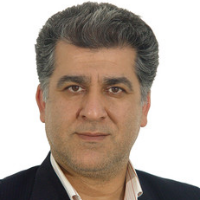Petrology and tectonic settings of the Sarcheshmeh porphyry copper deposit with emphasis on granodiorite and quartz eye porphyry
The Sarcheshmeh porphyry copper deposit (PCD) and other porphyry deposits occur in the the most important metallogenic belt in Iran, i.e. the Urumieh-Dokhtar magmatic belt (UDMB). The main phase of intrusion generation in various episodes of mineralization in the Sarcheshmeh area is a stock of granodiorite to tonalite (Shahabpour and Kramers, 1987) that is called the Sarcheshmeh porphyry. This stock intruded volcano-sedimentary rocks and alteration has centered on it. The oldest rock units of the area are Eocene volcanic rocks (Waterman and Hamilton, 1975), which are mainly andesites accompanying marine sedimentary rocks that is consistent with a submarine volcano-sedimentary basin environment. Granodiorite and quartz eye porphyry crop out in the northern part of the Sarcheshmeh PCD. The main objective of this study is to investigate their petrology and geotectonic environment.
Forty samples from drill cores and surface samples from granodiorite and quartz eye porphyry were collected. Twelve samples were chosen with the lowest degree of alteration (less than 5% of representative samples and low LOI) from amongst them for lithogeochemical analyses by ICP-OES and ICP-MS. Lithogeochemical analysis of the main elements was carried out using ICP-OES (Inductively Coupled Plasma-Atomic Emission Spectroscopy) by lithiumborate fusion, and elemental analysis of trace and rare earth elements was performed by ICP-MS (Inductively Coupled Plasma-Mass Spectrometry) using sodium peroxide fusion in the SGS Company, Toronto, Canada.
Based on the Na2O+K2O versus SiO2 values on Cox et al. (1979) and Middlemost (1985) diagram, also R1-R2 diagram of De la Roche et al. (1980), the samples were plotted in the field of granodiorite and quartz diorite. On Harker diagrams, the contents of FeOt, CaO, p < sub>2O5, Al2O3, MgO, and TiO2 versus SiO2 show a decreasing pattern. Decreasing amounts of MgO and TiO2 can be related to early crystallization of ferromagnesian minerals and of CaO, Al2O3, and p < sub>2O5 to plagioclase and apatite crystallization, respectively. The chemical relationship and continuous pattern of the samples indicate that they probably resulted from fractionation of a unique magma. On the basis of the AFM diagram, they have calc-alkaline affinities. These observations and the presence of magnetite and other opaque minerals indicate high ƒO2 crystallization throughout fractionation stages. The samples of the study area were plotted in the calc-alkalic and alkali-calcic fields on a Frost et al. (2001) diagram and indicate that they are mainly magnesia consistent with oxidized I-type magmas.The spider-diagrams show negative anomalies in HFSE (especially Ti and Nb) and positive anomalies in LILE (especially in Ba and Rb). Negative anomalies of HFSE such as Ti, Nb, P and Ta can be related to the subduction of the Arabian plate under Central Iran and reflect the chemistry of the origin and crystallization-melting processes during evolution of the rocks. Moreover, it can be concluded that these elements remained in the source during partial melting, which is characteristics of I-type arc-related magmas. The behavior of LILE can be attributed to the behavior of fluid phases that were involved during the subduction. The REE diagrams show enrichment of LREE relative to HREE which can also be attributed to the subduction of the Arabian plate under Central Iran. Shafiei et al. (2009) and Asadi, 2018 proposed post-collision environment for the PCDs of the UDMB, especially in the Kerman part.By studying on the Dehaj-Sarduieh belt, Dargahi et al. (2010) concluded that the time of collision of the Arabian plate and the Central Iran continental plate was Late Eocene, and the Sarcheshmeh porphyry stock emplaced in post-orogenic environment like other stock porphyries of the UDMB. The samples of the Sarcheshmeh PCD plot in the mature arc area based on Rb vs Y+Nb diagram and it can be envisaged that they are related to the post-collision magmatic arc.
- حق عضویت دریافتی صرف حمایت از نشریات عضو و نگهداری، تکمیل و توسعه مگیران میشود.
- پرداخت حق اشتراک و دانلود مقالات اجازه بازنشر آن در سایر رسانههای چاپی و دیجیتال را به کاربر نمیدهد.




